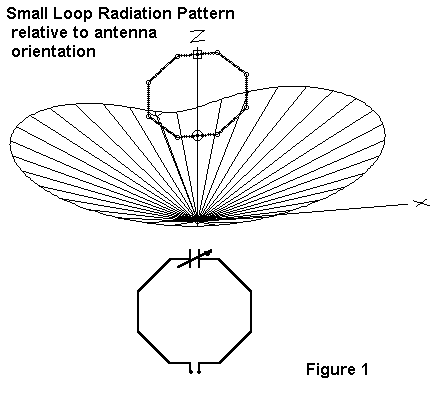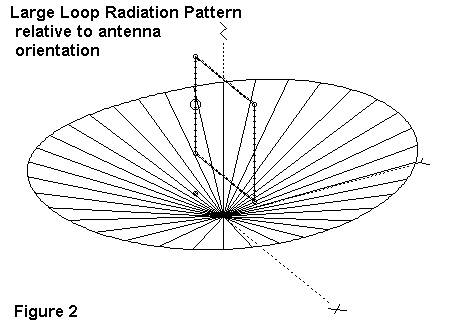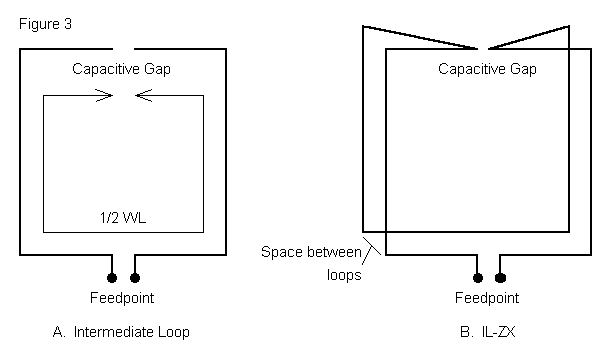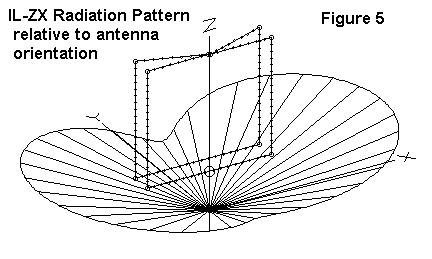
 The IL-ZX Antenna for 40 Meters
The IL-ZX Antenna for 40 MetersIL-ZX is shorthand for Intermediate Loop-Impedance Transformation antenna. The design has some of the properties of a small loop, for example radiation off the edges of the loop rather than off the face. However, it does not require the level of mechanical care associated with small loops and replaces the capacitor with a simple capacitive gap, the spacing of which resonates the loop. The native feedpoint impedance of such a loop, about 1/2 wavelength in circumference, is around 10 ohms. By using a double-loop form of construction, the impedance is raised to about 40 ohms.

Small loops require extreme care in construction, since every fraction of an ohm connection loss results in large increases in power lost to heat. Hence, 3/4" diameter copper water pipe, soldered at every joint, is a common material. The required resonating capacitor demands special care of construction and attachment. If one has the skills to build one, a small loop can be a very effective antenna. With a stepper motor operating the capacitor, a 2:1 frequency range of operation is easily possible with good results.
The full wavelength loop is capable of higher gain than a dipole placed at the center height of the loop. However, a large loop is about 1/4 wavelength on a side, about 35' horizontally and vertical on 40 meters. If fed at the bottom or top, the radiation pattern is largely horizontally polarized and subject to the same high-angle of maximum radiation as a dipole. Hence, low mounting heights reduce the effectiveness of this antenna.
Fed in the middle of one side, the antenna offers low angle radiation, largely vertically polarized. However, for maximum effectiveness, the antenna requires about 10' spacing above ground, raising its top height to about 45' or so. Figure 2 shows the pattern of a vertically polarized 40- meter large loop.

The full-size quad loop is but one of several SCV designs for achieving low angle vertically polarized radiation without need for a ground plane and without high angle radiation or reception of QRM and QRN from those upper angles. They have come into increased use by those who have directly or indirectly read into materials researched by ON4UN and others. Another entry in this series of notes attempts to put into perspective the entire spectrum of SCV antennas.
SCVs require significant real estate, either or both horizontally and vertically. The modern city lot or rental property does not always offer sufficient space even for a 40-meter SCV.

The feedpoint impedance can be raised to about 40 ohms by doubling the loop and feeding only one of the wires, as shown in Figure 3B. (Hence, ZX = Impedance Transformation.) This method is essentially the same impedance transforming technique used in the folded dipole. With wires of the same diameter at any spacing, the transformation is 4:1. This transformation applies to both radiation and heat components of the impedance, so no magical reduction in losses occurs--and likewise, no magical increase in gain occurs. However, the feedpoint impedance is now more manageable for use with 50-ohm coax.
A second benefit of the double loop is that it offers the builder standard techniques of wire antenna construction. The loops may be spaced from 6" to 3' apart with corner CPVC spacers. Wire joints should be carefully constructed and soldered. The antenna benefits from the use of large wire sizes, with 1" wire showing an additional 0.5 dB gain over #12 wire. Therefore, one may wish to build the antenna from such materials as 450-ohm parallel line for each loop to simulate fatter wire. If such a method is selected, it is usually wise to solder a short across the parallel line periodically to ensure equal currents on each wire. (Do not short the two loops except at the top gap.)

Figure 4 shows two arrangements for the top gap. In one case, the loops are brought together as a point; in the other they approach each other as a bar across the loop ends. Since the gap is actually the dielectrical space for a capacitor formed by the loop ends, the difference in construction can make a big difference in antenna size and adjustment. Models of the point- gap required about 18' per side for the antenna, with a gap between 0.2 and 1.0' wide, depending on spacing of the loops. The flat-gap antenna, for loops spaced at 2' and a gap of 0.8' required sides of only 17' each. The flat-gap construction will make side length a much more sensitive function of the loop spacing, since the capacitance between ends will change more radically with loop spacing and the consequential lengthening or shortening of the wires facing each other. In all cases, the builder should be prepared to do considerable experimentation to achieve resonance.
The 2:1 VSWR operating bandwidth is about 100 kHz at 40 meters. However, a network ATU in the line should expand this without introducing significant losses on this lower HF band where a full wavelength of coax feedline is over 90' long (accounting for velocity factor).

The primary signal direction of the IL is like that of the small loop: off the edges of the loop, as shown in Figure 5. With a center height of 15' or so, the elevation angle of maximum gain is 21 to 22 degrees, similar to SCV angles. Front-to-side ratio is generally around 10 dB.
The principle disadvantage to the antenna is low gain. The antenna gain at maximum is about 3 dB less than that of a full size quad loop and about 4.5 dB less than that of a half square, when each of these is at optimum height. The reduction is less than a full S-unit in signal strength.
However, the antenna offers two advantages that offset the reduction in gain. First, although not as narrow in reception bandwidth as a small loop, the sensitivity of the antenna to reception noise is considerably less than that of a resonant dipole or large loop. Second, the attenuation of signals at higher angles (in the 45-degree elevation angle range) reduces the reception strength of QRN and QRM. Hence, the signal-to-noise ratio of the antenna should be quite good for signals in the desired main lobes of the antenna. Since most receivers have excess gain at 40 meters, reception of desired distant signals should be a matter of increasing either pre-filtration or post-filtration gain.
Even if we become very conservative and estimate performance at 6 dB down (1 S-unit) from an optimized half square, the transmitting success ratio should only go down in contest and pile-up conditions. For QRP operation, raising power from an initial 1 watt to a final 4 watts would restore signal strength at the reception end.
The IL-ZX is not by any means a perfect antenna, designed to outperform anything else on the market. However, neither is any other antenna. Every set of performance figures carries with it a set of operating specifications within which performance is measured. We too often ignore this fact when evaluating antennas.
If vertical and horizontal space are at a premium and skills needed to
build an effective small loop are somewhere in the future, the IL-ZX may
serve as an effective low radiation angle antenna in the interim until a
perfect antenna site can be purchased. If you decide that you do not like
the antenna, you can likely put the materials to use on other projects.
Updated 6-30-97. © L. B. Cebik, W4RNL. Data may be used for personal purposes, but may not be reproduced for publication in print or any other medium without permission of the author.